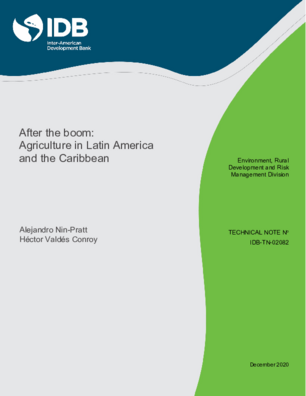After the Boom: Agriculture in Latin America and the Caribbean
Date
Dec 2020
The convergence of a favorable macroeconomic environment and high prices of primary commodities between 2000 and 2011 contributed to the best performance of agriculture in Latin America and the Caribbean (LAC) since the 1980s, with steady growth of total factor productivity (TFP) and output per worker and a reduction in the use of input per worker. The end of the upward phase of the commodity cycle in 2011 together with less favorable external markets and a deterioration of the policy environment in several countries, motivates us to revisit the situation of agriculture in LAC in recent years to analyze how these changes have affected its performance. This study applies a framework that uses index numbers together with data envelopment analysis (DEA) to estimate levels of productivity and efficiency, incorporating technical change together with technical (TE) and environmental efficiency (EE) into the decomposition of TFP. The EE index adjusts the TFP measure for pollution, treating GHG emissions as a by-product of the desired crop or livestock outputs. TFP and efficiency of crop and livestock sub-sectors was calculated for 24 LAC countries from 2000 to 2016. Our results show that the period of fast agricultural growth in LAC, driven by technical change and resource reallocation, transformed agriculture in the region leaving it in a better position to cope with the more unfavorable regional macroeconomic environment and the less dynamic global markets observed after 2011.




